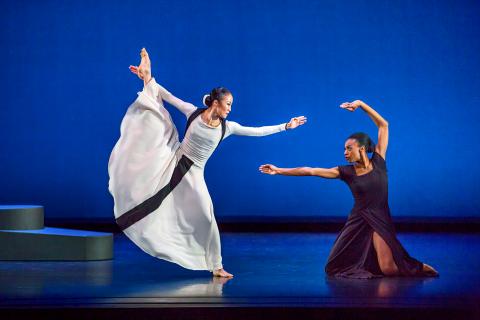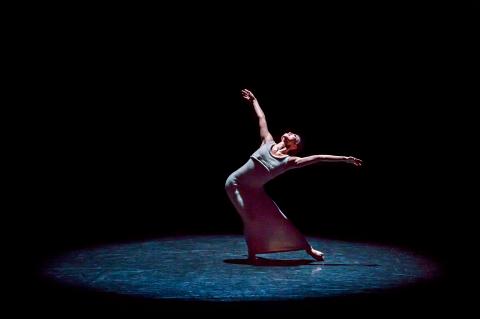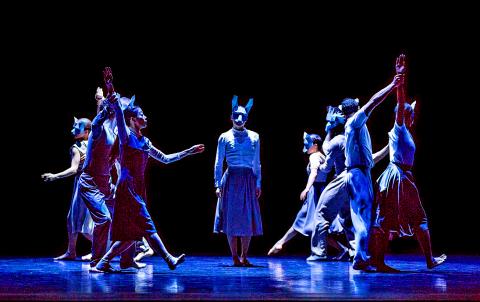Twelve years ago this month, a young Taipei National University of the Arts (TNUA, 國立臺北藝術大學) student was in the audience at the National Theater to watch the Martha Graham Dance Company and one of its principal stars, Yilan-born TNUA alumnus Sheu Fang-yi (許芳宜) perform.
Next week, that student will be headlining the company’s return to Taipei, when it will give four performances at the Sun Yat-sen Memorial Hall.
Chien Pei-ju (簡珮如), or PeiJu Chien-Pott as she is known outside of Taiwan, said she cannot wait.

Photo courtesy of Brigid Pierce
Not just for the chance to perform the Graham roles that she has made her own in recent years in front of family, friends and former professors, but to enjoy her favorite Taiwanese breakfasts and other dishes she misses when she is at home with her husband and seven-year-old daughter in New Jersey.
Next week’s trip will cap a very busy eight months for Chien-Pott, a time that has seen her bounce back and forth between Taiwan and the US more than normal.
She was in Taipei in August last year for rehearsals and to perform in the opening ceremony of the Taipei Universiade, received the Bessie Award for Outstanding Performer on Oct. 9, came back to Taipei in to deliver a talk on Oct. 20 at the Taipei International Convention Center and receive an “outstanding alumni” award alongside classmate and choreographer Huang Yi (黃翊) from TNUA the following day, went to China for a week and returned to the US for the start of the company’s 2017-2018 season.

Photo courtesy of Brigid Pierce
She won the Bessie — the NY Dance and Performance Awards — for her performances of Graham’s Ekstasis, with the award committee praising her for “bringing to life a lost Martha Graham solo from 1933, masterfully inhabiting the … movements … and embodying the very essence of Graham’s ecstatic vision.”
DANCING TO NEW YORK
I caught up with Chien-Pott via Skype on Wednesday last week at her New Jersey home during a brief respite after a four-week tour that had taken the company to Luxembourg, the Netherlands, Germany and Canada, bookended by several performances in Florida.

Photo courtesy of Brigid Pierce
I asked about her start in dance, the company’s program in Taipei and her plans for the future.
She said she started taking classes in kindergarten, and by fourth grade she had begun to get serious about dancing.
“My mom had sent me to a bunch of afterschool classes — piano, violin, calligraphy, dance — but I got the most satisfaction from dance. I felt confident when I danced,” she said. “In fourth grade, I asked my mom to sign me up for a private dance school. Then, when I applied for middle school, I entered a school that had a special dance course.”
Three years later, Chien-Pott auditioned for TNUA’s seven-year dance program, which goes from high school to a bachelor’s degree. She was nervous, because by that time the university’s five-year dance program had already produced a lot of stars, she said.
“I remember the day before the audition, my father and mom and I drove to the Guandu Temple (關渡宮) to pray for a smooth audition and then we walked around the campus, checking it out. My dad said, ‘I think I am going to be here often,’” she said.
She was accepted into the second group of seven-year students, one that included Huang Yi and several others who have gone on to prominent careers.
“At TNUA I had a lot of great teachers, like Lo Man-fei (羅曼菲), Zhang Xiao-xiong (張曉雄), Ku Ming-shen (古名伸); I felt like I was in the top program, very honored and very special,” she said.
However, she was decidedly underwhelmed by her first exposure to Graham’s movement technique.
“I took a Graham technique class taught by Ross Parkes in my first year at TNUA, but I didn’t like it. I thought it went against the human body. I was more focused on ballet and other classes,” she said.
By the time Chien-Pott was a university sophomore, some of her professors were impressed enough to ask her to dance for their Crossover Dance Company (台北越界舞團), which she continued to do even after graduation. She also danced with Wu Ching-yin’s (吳青吟) Taipei Royal Ballet (台北皇家芭蕾舞團).
She credits that sophomore year experience with Crossover to giving her the idea that she could become a professional dancer.
However, she wanted to get a masters’ degree in dance education at New York University, and so 10 years ago she traded life in Taiwan for New York City.
“First, I had to take English-language classes to prep for the master’s program, but I took dance classes every day after class. One day a teacher asked if I wanted to dance with a professional company, saying that I didn’t belong in a studio class,” she said. “I met the director of the Buglisi Dance Company and got a job with them.”
Suddenly she was surrounded by people who were experts in Graham technique. The Buglisi troupe had been founded by four former principal dancers with the Graham company, and the man who became her husband, Nimbus Dance Works founder and director Samuel Pott, had been a Graham soloist.
However, she failed in her first attempt to join the Graham company. Continuing to work with other troupes in the New York City area such as Korhan Basaran Artists, Morphoses and Nimbus, she married Pott and they had a daughter.
She auditioned for the Graham troupe a second time and was hired as an apprentice in 2011.
When I interviewed Chien-Pott in August last year about her Universiade appearance, she laughed as she remembered that many people had told her that having a child could end her dancing career — but in fact her career had really only taken off afterwards, although balancing work and family was a challenge.
She rose rather quickly in the company, winning promotion to principal dancer in 2014, the same year she shared the Positano Premia La Danza Contemporary Dance award with Random Dance’s Alvaro Dule, and Dance Magazine named her one of the “Best Performers.”
RETURNING HOME WITH GRAHAM
Chien-Pott said her admiration for Graham’s work and her techniques has only grown stronger over the years.
“I came to appreciate it, especially the dramatic roles… Somehow it all began to make sense to me, when I use that technique/movement in a role. It’s amazing,” she said. “It’s a perfect marriage between movement and emotion.”
“A lot of the coaches will say: “Why do you do that? You don’t have to tell me, but you need to know why,” she said.
Despite her success abroad, it was not until two-and-a-half years ago that her parents were able to see her perform with the Martha Graham Dance Company, when they traveled to China to see the troupe in Beijing and Shanghai.
She said last August that she was thrilled the troupe would be back in Taipei this month. Last week she was even happier.
“I am very excited about the tour. I have been waiting for years,” she said. “It’s been more than a decade since the company’s last visit to Taipei. It is a very different company now … since 2014, the company started a new path, inviting other choreographers. The new commissions are all inspired by Graham’s legacy.”
It is not just new works that are keeping the company’s look fresh, as she mentioned that the costumes and set for Graham’s 1984 work Rite of Spring were redesigned three to four years ago.
However, she is looking forward to more than just performing next weekend.
“I can’t wait to have some Taiwanese food, especially breakfasts. I miss it very much: soybean milk, scallion cakes (蔥油餅), danbing (蛋餅, egg pancakes) — I am emotional just thinking about it,” she said.
She is also thinking about her eventual post-Graham future, and doing more work in Taiwan.
“I have started my own company [PJ Contemporary Dance Company (簡珮如當代舞蹈空間)] and I am looking forward to using it as a platform to present work as a performer and to collaborate with choreographers and other artists,” she said. “I want to open an opportunity for younger dancers to work with professionals, like I did with Crossover.”
The Graham company will be doing two different programs in Taipei and has double casts for each program, she said.
The programs should give audiences a good idea of why Graham became such a powerhouse in the modern dance world, and how her technique — which is based on contractions and release as part of the cycle of breathing, the spiraling of a dancer’s torso and falling — revolutionized dance.
Graham founded her company in 1926, when she was 32, and continued to choreograph into her 90s, with many of her works inspired by Greek mythology and US history.
Program A on Friday and Saturday nights features Dark Meadow Suite, an arrangement of highlights from Dark Meadow (1946); Ekstasis, Lamentation Variations and Chronicle (1936).
Program B for the Saturday and Sunday matinees features Steps in the Street (1936), Errand into the Maze (1947); Woodland (2016) by Swedish choreographer Pontus Lidberg and Rite of Spring (1984).
Chien-Pott will be dancing Ekstasis and Chronicle on Friday night, as well as Rite at the Sunday matinee. She said Rite is perhaps her favorite of all the Graham works she has danced.
However, she is not the only TNUA alumnus who will highlighted in the company’s shows.
Lamentation Variations will feature choreographer Bulareyaung Pagarlava’s contribution to a project the company began in 2007 to commission modern choreographers to create a dance honoring Graham’s famous 1930 paean to grief, Lamentation.
Lamentation Variations begins with a film clip of Graham and then three variations from among the eight commissioned so far; Bulareyaung’s 2009 version will be one of the three staged in Taipei.
Tickets are available online at udnfunlife.com or at convenience store kiosks.

April 14 to April 20 In March 1947, Sising Katadrepan urged the government to drop the “high mountain people” (高山族) designation for Indigenous Taiwanese and refer to them as “Taiwan people” (台灣族). He considered the term derogatory, arguing that it made them sound like animals. The Taiwan Provincial Government agreed to stop using the term, stating that Indigenous Taiwanese suffered all sorts of discrimination and oppression under the Japanese and were forced to live in the mountains as outsiders to society. Now, under the new regime, they would be seen as equals, thus they should be henceforth

Last week, the the National Immigration Agency (NIA) told the legislature that more than 10,000 naturalized Taiwanese citizens from the People’s Republic of China (PRC) risked having their citizenship revoked if they failed to provide proof that they had renounced their Chinese household registration within the next three months. Renunciation is required under the Act Governing Relations Between the People of the Taiwan Area and the Mainland Area (臺灣地區與大陸地區人民關係條例), as amended in 2004, though it was only a legal requirement after 2000. Prior to that, it had been only an administrative requirement since the Nationality Act (國籍法) was established in

With over 80 works on display, this is Louise Bourgeois’ first solo show in Taiwan. Visitors are invited to traverse her world of love and hate, vengeance and acceptance, trauma and reconciliation. Dominating the entrance, the nine-foot-tall Crouching Spider (2003) greets visitors. The creature looms behind the glass facade, symbolic protector and gatekeeper to the intimate journey ahead. Bourgeois, best known for her giant spider sculptures, is one of the most influential artist of the twentieth century. Blending vulnerability and defiance through themes of sexuality, trauma and identity, her work reshaped the landscape of contemporary art with fearless honesty. “People are influenced by

Three big changes have transformed the landscape of Taiwan’s local patronage factions: Increasing Democratic Progressive Party (DPP) involvement, rising new factions and the Chinese Nationalist Party’s (KMT) significantly weakened control. GREEN FACTIONS It is said that “south of the Zhuoshui River (濁水溪), there is no blue-green divide,” meaning that from Yunlin County south there is no difference between KMT and DPP politicians. This is not always true, but there is more than a grain of truth to it. Traditionally, DPP factions are viewed as national entities, with their primary function to secure plum positions in the party and government. This is not unusual